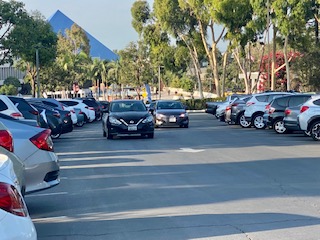Long Beach State’s parking capacity and permit prices have been a topic of interest and concern since the return of in-person classes as a majority of students commute to campus.
When the COVID-19 pandemic forced classes to move online for a year-and-a-half, CSULB’s parking permit sales dropped, and the campus became like a ghost town.
After a 70% drop in revenue, the university increased parking permit prices during the 2019 to 2020 academic year. During this time, the campus had a $10.8 million revenue from the purchase of permits, citations and events among other revenue sources. Still, the university spent $9.6 million on costs, including paying off parking structure loans, admin operations and renovations.
Now, CSULB has created a five-year plan, starting this fall semester, that will continue to increase the price of every parking permit fee, including semester and daily.
The Fall 2021 – Parking Fee Schedule video on the CSULB parking and transportation services website explains that the increase in permit prices is necessary to create a “sustainable parking budget” and cover the “vital infrastructure repairs needed this year.”
Chad Keller, a digital content specialist for parking and operations, said the department’s leading source of revenue comes from students’ parking permits, which make up 86% of the department’s funds.
As a result of permit sales dropping, the university expects revenue of $1.5 million this year, creating about $7 million in loss, according to the Parking and Transportation Annual Report.
Despite the university’s 21.4% in revenue loss, many students, including third-year psychology major Jayme Preijers, said they felt the price increases to create a sustainable parking budget were not reasonable because there are not enough spots close enough to the upper campus, making it difficult to secure a parking spot that does not require a 15-minute walk to class.
“I think paying close to $300 and struggling to find parking is an issue,” Preijers said.
CSULB has the most parking spaces available out of all the Cal States with just a little over 14,000. Lots G1, G3, and G4 are the most popular among drivers since they are the closest spaces to both upper and lower campuses. This means these lots often reach max capacity as early as 8 a.m.

Meleia Vyrak, a fourth-year microbiology major, has managed to secure a parking spot in lot G3 in the early mornings.
“It’s kind of difficult to get good parking, especially if you’re in a rush,” Vyrak said. “If you wake up late one day trying to find a parking spot close to upper campus, you’re not going to find it or get it.”
Similar to Vyrak, third-year liberal arts major Megan Payton, was also lucky enough to find a parking spot in G4 which is also a busy lot.
“It’s pretty bad, I will normally circle lot G4 about 20 times,” Payton said. “And this is the only day I found a parking spot right away.”
Lower campus parking lots such as G9, G11 and the structures offer dozens of available spaces for students throughout the day, however, they are not optimal places to park due to the far distance from the heart of the campus.
Carpooling to campus has helped resolve parking problems for students such as third-year psychology major, Norma Bernal and third-year marine biology major, Ally Gomez.
Bernal said she usually “avoids waiting for parking spots” because her “classes are early in the morning.”
Third-year kinesiology major, Ally Collins added that students can share a parking permit with a friend to save money.
“As long as only one car is on campus at a time, it is a more affordable solution,” Collins said.
For more information on CSULB permit parking, visit the parking and transportation website.




